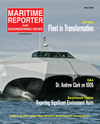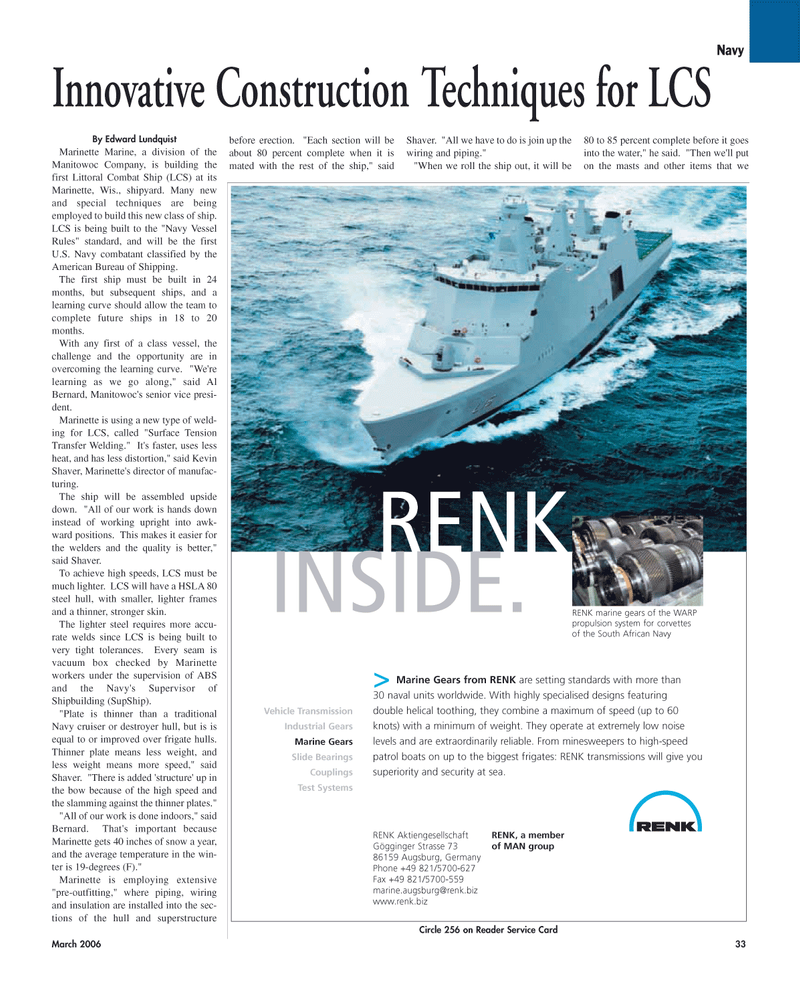
Page 33: of Maritime Reporter Magazine (March 2006)
The Training & Education Edition
Read this page in Pdf, Flash or Html5 edition of March 2006 Maritime Reporter Magazine
March 2006 33
By Edward Lundquist
Marinette Marine, a division of the
Manitowoc Company, is building the first Littoral Combat Ship (LCS) at its
Marinette, Wis., shipyard. Many new and special techniques are being employed to build this new class of ship.
LCS is being built to the "Navy Vessel
Rules" standard, and will be the first
U.S. Navy combatant classified by the
American Bureau of Shipping.
The first ship must be built in 24 months, but subsequent ships, and a learning curve should allow the team to complete future ships in 18 to 20 months.
With any first of a class vessel, the challenge and the opportunity are in overcoming the learning curve. "We're learning as we go along," said Al
Bernard, Manitowoc's senior vice presi- dent.
Marinette is using a new type of weld- ing for LCS, called "Surface Tension
Transfer Welding." It's faster, uses less heat, and has less distortion," said Kevin
Shaver, Marinette's director of manufac- turing.
The ship will be assembled upside down. "All of our work is hands down instead of working upright into awk- ward positions. This makes it easier for the welders and the quality is better," said Shaver.
To achieve high speeds, LCS must be much lighter. LCS will have a HSLA 80 steel hull, with smaller, lighter frames and a thinner, stronger skin.
The lighter steel requires more accu- rate welds since LCS is being built to very tight tolerances. Every seam is vacuum box checked by Marinette workers under the supervision of ABS and the Navy's Supervisor of
Shipbuilding (SupShip). "Plate is thinner than a traditional
Navy cruiser or destroyer hull, but is is equal to or improved over frigate hulls.
Thinner plate means less weight, and less weight means more speed," said
Shaver. "There is added 'structure' up in the bow because of the high speed and the slamming against the thinner plates." "All of our work is done indoors," said
Bernard. That's important because
Marinette gets 40 inches of snow a year, and the average temperature in the win- ter is 19-degrees (F)."
Marinette is employing extensive "pre-outfitting," where piping, wiring and insulation are installed into the sec- tions of the hull and superstructure before erection. "Each section will be about 80 percent complete when it is mated with the rest of the ship," said
Shaver. "All we have to do is join up the wiring and piping." "When we roll the ship out, it will be 80 to 85 percent complete before it goes into the water," he said. "Then we'll put on the masts and other items that we
Innovative Construction Techniques for LCS >
Marine Gears from RENK are setting standards with more than 30 naval units worldwide. With highly specialised designs featuring double helical toothing, they combine a maximum of speed (up to 60 knots) with a minimum of weight. They operate at extremely low noise levels and are extraordinarily reliable. From minesweepers to high-speed patrol boats on up to the biggest frigates: RENK transmissions will give you superiority and security at sea.
RENK Aktiengesellschaft
Gögginger Strasse 73 86159 Augsburg, Germany
Phone +49 821/5700-627
Fax +49 821/5700-559 [email protected] www.renk.biz
RENK, a member of MAN group
RENK marine gears of the WARP propulsion system for corvettes of the South African Navy
Vehicle Transmission
Industrial Gears
Marine Gears
Slide Bearings
Couplings
Test Systems
RENK
INSIDE.
Circle 256 on Reader Service Card
Navy
MR MARCH2006 #5 (33-40).qxd 3/2/2006 11:39 AM Page 33

 32
32

 34
34
